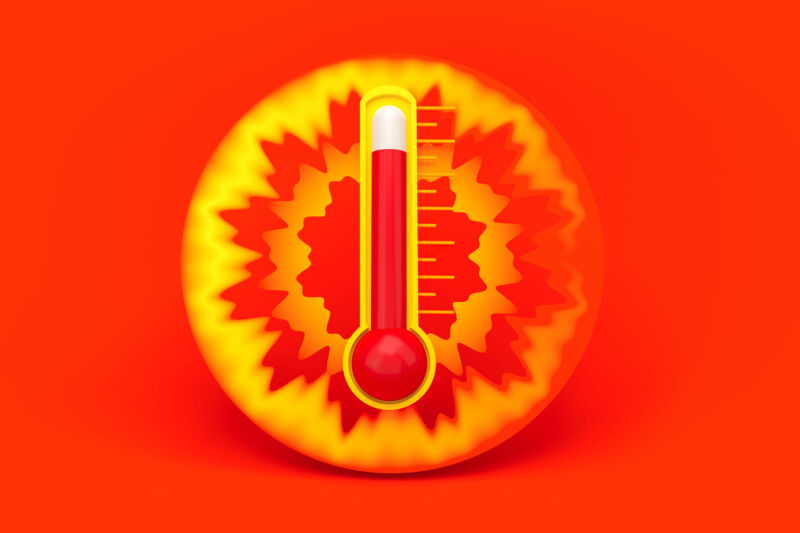Reading view
White House Takes a Tiny Bite From Giant Pile of Food Waste

© Andri Tambunan for The New York Times
Bill Gates Is Backing a Nuclear Power Project in Wyoming

© Benjamin Rasmussen for The New York Times
We’ve just had a year in which every month was a record-setter

Enlarge (credit: Uma Shankar sharma)
June 2023 did not seem like an exceptional month at the time. It was the warmest June in the instrumental temperature record, but monthly records haven't exactly been unusual in a period where the top 10 warmest years on record have all occurred within the last 15 years. And monthly records have often occurred in years that are otherwise unexceptional; at the time, the warmest July on record had occurred in 2019, a year that doesn't stand out much from the rest of the past decade.
But July 2023 set another monthly record, easily eclipsing 2019's high temperatures. Then August set yet another monthly record. And so has every single month since, a string of records that propelled 2023 to the warmest year since we started keeping track.
Yesterday, the European Union's Copernicus Earth-monitoring service announced that we've now gone a full year where every single month has been the warmest version of that month since we've had enough instruments in place to track global temperatures.
How a Climate Backlash Influenced Campaigning in Europe

© Kenzo Tribouillard/Agence France-Presse — Getty Images
An Oregon Forest Is in Trouble. Part of the Response: Logging.

© Amanda Loman/Associated Press
‘Hanging by a Thread’: U.N. Chief Warns of Missing a Key Climate Target

© R. Satish Babu/Agence France-Presse — Getty Images
Alameda Ends Cloud-Brightening Test, Overruling Staff Decision

India’s Next Government Will Face Serious Climate Challenges

© Arun Sankar/Agence France-Presse — Getty Images
Brazil’s Deadly Flooding Made Twice as Likely by Global Warming, Study Finds

© Anselmo Cunha/Agence France-Presse — Getty Images
Saudi Arabia Eyes a Future Beyond Oil

© Iman Al-Dabbagh for The New York Times
Carbon Offsets, a Much-Criticized Climate Tool, Get Federal Guidelines

© Zinyange Auntony/Agence France-Presse — Getty Images
Climate Change Added a Month’s Worth of Extra-Hot Days in Past Year

© Fareed Khan/Associated Press
Climate Change Is Taking a Toll on Mites and Springtails, a New Analysis Finds
These Teens Adopted an Orphaned Oil Well. Their Goal: Shut It Down.

© Cornell Watson for The New York Times
Some Wind Turbines in Iowa Crumpled by Tornadoes

© Charlie Neibergall/Associated Press
Is Biodegradable Plastic Really a Thing?
Thunderstorms, Wind and Climate Change: Here’s What to Know

© David J. Phillip/Associated Press
Heat Stress Is Hitting Caribbean Reefs Earlier Than Ever This Year

© Jorge Silva/Reuters
Meet the Marine Biologist Who Works for a Hotel Chain
Summer 2023 Was the Northern Hemisphere’s Hottest in 2,000 Years, Study Finds

© Arpad Benedek/Alamy
Alarmed by Climate Change, Astronomers Train Their Sights on Earth

© David Maurice Smith for The New York Times
New Rules to Overhaul Electric Grids Could Boost Wind and Solar Power

© Renaud Philippe for The New York Times
Alameda Officials Stop Cloud Brightening Study Aimed at Cooling Planet

© Ian C. Bates for The New York Times
California Will Add a Fixed Charge to Electric Bills and Reduce Rates

© Jim Wilson/The New York Times
From Ancient Charcoal, Hints of Wildfires to Come
Tuna Crabs, Neither Tuna Nor Crabs, Are Swarming Near San Diego
10 Big Biden Environmental Rules, and What They Mean

© Tom Brenner for The New York Times
The U.S. Is Getting More Heavy Tornado Days. Scientists Are Trying to Figure Out Why.

© Ronald W. Erdrich/The Abilene Reporter-News, via Associated Press
Podesta Meets With China’s Climate Envoy Amid Deep Economic Tensions

© Agence France-Presse — Getty Images
Environmental Changes Are Fueling Human, Animal and Plant Diseases, Study Finds

© Bill Draker/Rolf Nussbaumer Photography, via Alamy
Gas Stove Pollution Risk Is Greatest in Smaller Homes, Study Finds

© Calla Kessler for The New York Times
Some NASA Satellites Will Soon Stop Sending Data Back to Earth

© NASA/GSFC/LaRC/JPL, MISR Team
What Makes a Society More Resilient? Frequent Hardship.

© Wirestock, Inc., via Alamy
Drought That Snarled Panama Canal Was Linked to El Niño, Study Finds

© Nathalia Angarita for The New York Times
Energy Dept. Releases New Efficiency Rules for Water Heaters and Other Appliances

© Beth Hall for The New York Times
U.S. Plan to Protect Oceans Has a Problem, Some Say: Too Much Fishing

© Karsten Moran for The New York Times
Winners of the Goldman Environmental Prize Use Courts to Contest Oil Projects

© Rogan Ward/Reuters
Honda Commits to E.V.s With Big Investment in Canada

© Maddie McGarvey for The New York Times